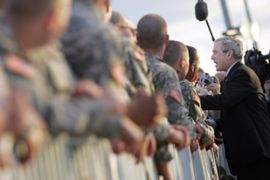Vying for power: the US and Iran
Tension grows in the Gulf as the US and Iran vie for power.

The US has recently sent a second aircraft carrier to the Gulf, it regularly accuses Iran of supplying weapons to fighters in Iraq as well as other Arab countries and George Bush, the US president, has ordered oil reserves to be stockpiled.
‘War of words’
Al Jazeera’s Rob Reynolds said: “Even before US warships sailed for the Persian Gulf a war of words had begun, with George Bush ratcheting up the rhetoric against Tehran.”
In a press conference on February 14, Bush said: “There are weapons in Iraq that are harming US troops … because of the Quds force. And as you know, I hope, that the Quds force is a part of the Iranian government. Whether Ahmadinejad ordered the Quds force to do this, I don’t think we know. But we do know that they’re there, and I intend to do something about it.”
|
“President Bush tends to speak hot rhetoric, and not follow up with cool actions. I think he’s going to have to close that gap, he’s losing credibility” Raymond Tanter of the Iran Policy Group |
Neoconservatives are campaigning for Bush to attack Iran or at least step up efforts to destabilise the Iranian government.
Raymond Tanter of the Iran Policy Group said: “President Bush tends to speak hot rhetoric, and not follow up with cool actions. I think he’s going to have to close that gap, he’s losing credibility.”
Meanwhile Iran has been practicing war games in the Gulf, and Ahmadinejad has been making his own contribution to the war of words.
He has said “the Iranian nation will defend its rights to the end” and declared nuclear power the “key to the preservation of Iranian civilization”.
Analysts say both sides’ bellicose rhetoric creates its own momentum, moving the nations closer to conflict.
Stephen Clemons of the New America Foundation said: “I would say we are on a railroad track, that we have been laying the track and it’s very very hard to pivot to something else.”
But there may be less to the tough talk than meets the ear. Recently Iran has adopted a more conciliatory tone and the Bush administration has reaffirmed a commitment to diplomacy.
Tony Snow, the White House spokesman said on February 12: “This is clearly a case where people are hyping something up. I don’t know how much clearer we can be: We’re not getting ready for war in Iran.”
Arms shopping
Al Jazeera’s Hashem Ahelbarra suggests the repercussions for the whole region could be felt at the recent International Arms Show in Abu Dhabi, which many Gulf countries attended with shopping lists running into the billions.
General Saleh Bin Ali al-Muhaiya, the Saudi chief of military staff who attended the show, was keen to play down his country’s concern over Iran.
He said: “I feel that Iran does not represent a threat because relations [are] still going very good and there are mutual contracts between senior leadership and we don’t really intend to acquire any new weapons systems to encounter Iran because we don’t categorise Iran as a potential enemy for our country.”
However, Ahelbarra says Saudi Arabia, along with other Gulf countries, set new spending records at the show.
US military presence
Many Gulf nations have also increased their cooperation with the US military in the region.
| Your Views |
|
“I believe there is a widely available diplomatic solution that the people of both America and Iran want”
|
In Oman up to three airbases are believed to house B-1 bombers and air refuelling aeroplanes while the aircraft carrier Dwight D. Eisenhower is currently positioned off the coast of Oman.
Neighbouring United Arab Emirates is home to deepwater ports, an airbase and logistical depots while Qatar is home to US central command. The al-Udied base in Qatar accommodates up to 100 aircrafts and is the Gulf’s longest airstrip.
The fifth fleet headquarters is in Bahrain with attack submarines, cruisers and destroyers. Kuwait is home to hundreds of fighter planes and assault helicopters along with thousands of army and air-force personnel.
Iranian military might
Iran is now the region’s biggest military power and is believed to have around 300 combat aircraft, more than 1600 battle tanks and a combined armed force of more than 545,000 with up to 300,000 reserves.
But as Gulf countries wait to see what will happen, many are preparing for the worst.
Ahelbarra says: “There is a tangible fear of a confrontation between the US and Iran. People here think they may suffer the consequences of such a conflict. It is this fear that makes local leaders ready to spend so much to the benefit of the arms industry.”